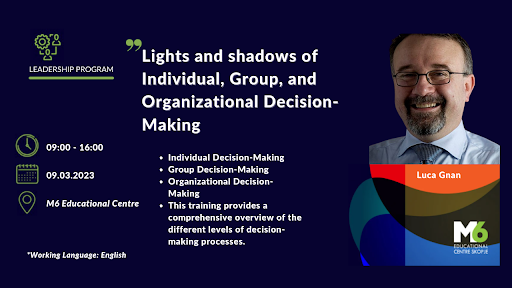
A) OUTLINE
1. Individual Decision-Making
- The Link Between Perception and Individual Decision-Making
- Biases and Errors, I can make in my decisions
- What is my Decision-Making Style?
2. Group Decision-Making
- Shadows of grey of Group Decision-Making
- Problems with Group Decision-Making
3. Organizational Decision-Making
- The Decision-Making Process
- Participative Decision-Making Techniques: Who and How involve people?
- Creative Decision-Making, Innovation, and Decision-Making in Organizations
B) Short Summary
The training “Lights and shadows of Individual, Group, and Organizational Decision-Making” explores the different aspects of decision-making processes at various levels, highlighting their benefits and challenges. The training is structured into three main sections:
- Individual Decision-Making,
- Group Decision-Making,
- Organizational Decision-Making.
The first section, Individual Decision-Making, focuses on how individuals perceive and make decisions. The lecturer emphasizes the link between perception and decision-making, stating that how we perceive things affects our choices. Biases and errors individuals can make in their decision-making are also discussed, with examples of cognitive biases such as confirmation bias, anchoring bias, and framing effects. The lecturer encourages individuals to be aware of their biases and errors in decision-making to 2 avoid making poor decisions. The first section concludes by discussing different decision-making styles and how individuals can identify their styles to make more effective decisions.
The second section, Group Decision-Making, discusses the benefits and challenges of making decisions in a group setting. The lecturer highlights the “shadows of grey” of group decision-making, such as groupthink, social loafing, and conformity. The potential problems with group decision-making are also discussed, such as time-consuming processes and the possibility of dominant personalities overshadowing other group members. The second section concludes with suggestions for improving group decision-making, such as setting clear goals and expectations, establishing effective communication channels, and promoting diversity of opinions.
The third section, Organizational Decision-Making, explores the decision-making processes within an
organizational context. The lecturer discusses the various stages of the decision-making process, such as identifying the problem, generating alternatives, and evaluating options. The lecture also covers participative decision-making techniques, such as brainstorming, consensus building, and delegation of decision-making authority. The third section emphasizes the importance of involving the right people in the decision-making process and how to engage them effectively. The third section concludes with a discussion on creative decision-making, innovation, and how organizations can use these techniques to make better decisions.
Overall, the training provides a comprehensive overview of the different levels of decision-making
processes. The lecturer highlights the benefits and challenges of each level and offers suggestions on how to improve decision-making processes.
The training emphasizes the importance of awareness, effective communication, and involving the right people in decision-making to achieve the best outcomes.
About the trainer:
Luca Gnan is Full Professor of Organizational Behavior at Tor Vergata University. He is also Professor
Honoris Causa at UACS – University American College at Skopje.
He is the President of Italian Association for Organization Studies (ASSIOA) and the past-president of
the European Academy of Management (EURAM).
He is Member of the Central Evaluation Committee of the Tor Vergata University and Board member of the Tor Vergata World University. He is and has been involved in various academic and public associations, including membership of the Education Ethics Executive Committee of AOM (Academy of Management), AOM BPS Division representative for Europe, AOM OMT Division Research Committee, Vice-President and Executive director of EURAM (European Academy of Management), Review Board member of FERC (Family Enterprise Research Conference), Sub-theme Convenor of EGOS (European Group of Organizational Studies), and Stream Chair of CMS (Critical Management Studies. He is also a Scientific Committee Member of the Master on Internationalization “CorCE Fausto De Franceschi” of the Italian International Trade Institute, with responsibility for Strategy and Organization. Luca Gnan is Editor in chief of the International Journal of transition and Innovation and he has been and is guest editor of various journals, and he has published on topics related to family business governance, corporate and public governance. Recently, he started to investigate family firms’ HR/Organizational issues, with a special interest in HRM Practices.






























